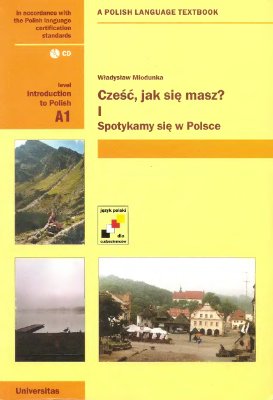Издатель: Universitas
Год выпуска: 2006
Количество страниц: 264
Аудио кодек: MP3
Битрейт аудио: 320 kbps
ISBN: 978-8324206339
Язык курса: Английский, Польский Учебник польского языка, написанный специально для английскоязычных читателей. Идеально подходит для тех, кто начинает изучать польский язык с нуля. Уровень A1. "Czesc , jak sie masz?" Part 1: "Spotykamy sie w Polsce" is the first communicative coursebook of Polish for level A
1. It contains 13 lesson units. Each lesson comprises passages in Polish with a Polish-English glossary, a vocabulary chart, grammar and communication notes in English, as well as exercises in grammar and oral communication. The coursebook provides information about Polish culture, e.g. the largest cities, geographical regions, Polish people and the Polish diaspora, Polish holidays, eminent Poles. The book ends with a test of Polish (in listening and reading comprehension, writing and speaking) at level A
1. Next in the series is the coursebook for level A
2. "Czesc, jak sie masz" Part II: "Spotkajmy sie w Europie".
The second volume of the coursebook Czesc, jak sie masz? Spotkajmy sie w Europie! is designed for leaers of polish at the A2 level.
1. How to give people best wishes on holidays and namedays. Imperative mood.
2. Ordinal, cardinal numbers, hours.
3. How to ask and give advice. Irregular verb powinien and verbal collocations with the verbs prosi , musie , trzeba, warto, powinien
4. How to express conce and anxiety. Dative of personal pronouns. How Christmas is celebrated in Poland.
5. How to write private and formal letters in Polish. Future tense.
6. Expressions and sentences which are useful while travelling in Poland. Compartison of adjectives. Degrees of intensivity of qualities.
7. Geographical facts about Poland. Prepositions. Cases.
8. How to ask permissions and give commands. Comparison of adverbs.
9. How to form the conditional mood and use it in polite offers, invitations, and requests.
10. Phrases and expressions used in telephone conversations.
11. Forms of genitive and accusative plural.
12. How to conduct a conversation
13. How to form the nominative plural of masculine nouns, used when talking about groups of people and groups of men.
14. Spotkajmy sie w Europie. Declension of Polish names and suames. + Polish-English Dictionary + Language Proficiency test for level A2.
Год выпуска: 2006
Количество страниц: 264
Аудио кодек: MP3
Битрейт аудио: 320 kbps
ISBN: 978-8324206339
Язык курса: Английский, Польский Учебник польского языка, написанный специально для английскоязычных читателей. Идеально подходит для тех, кто начинает изучать польский язык с нуля. Уровень A1. "Czesc , jak sie masz?" Part 1: "Spotykamy sie w Polsce" is the first communicative coursebook of Polish for level A
1. It contains 13 lesson units. Each lesson comprises passages in Polish with a Polish-English glossary, a vocabulary chart, grammar and communication notes in English, as well as exercises in grammar and oral communication. The coursebook provides information about Polish culture, e.g. the largest cities, geographical regions, Polish people and the Polish diaspora, Polish holidays, eminent Poles. The book ends with a test of Polish (in listening and reading comprehension, writing and speaking) at level A
1. Next in the series is the coursebook for level A
2. "Czesc, jak sie masz" Part II: "Spotkajmy sie w Europie".
The second volume of the coursebook Czesc, jak sie masz? Spotkajmy sie w Europie! is designed for leaers of polish at the A2 level.
1. How to give people best wishes on holidays and namedays. Imperative mood.
2. Ordinal, cardinal numbers, hours.
3. How to ask and give advice. Irregular verb powinien and verbal collocations with the verbs prosi , musie , trzeba, warto, powinien
4. How to express conce and anxiety. Dative of personal pronouns. How Christmas is celebrated in Poland.
5. How to write private and formal letters in Polish. Future tense.
6. Expressions and sentences which are useful while travelling in Poland. Compartison of adjectives. Degrees of intensivity of qualities.
7. Geographical facts about Poland. Prepositions. Cases.
8. How to ask permissions and give commands. Comparison of adverbs.
9. How to form the conditional mood and use it in polite offers, invitations, and requests.
10. Phrases and expressions used in telephone conversations.
11. Forms of genitive and accusative plural.
12. How to conduct a conversation
13. How to form the nominative plural of masculine nouns, used when talking about groups of people and groups of men.
14. Spotkajmy sie w Europie. Declension of Polish names and suames. + Polish-English Dictionary + Language Proficiency test for level A2.

